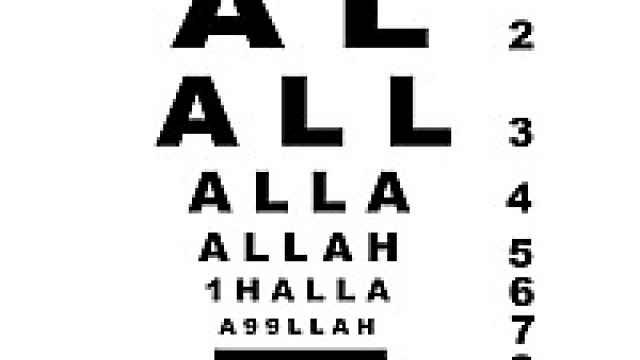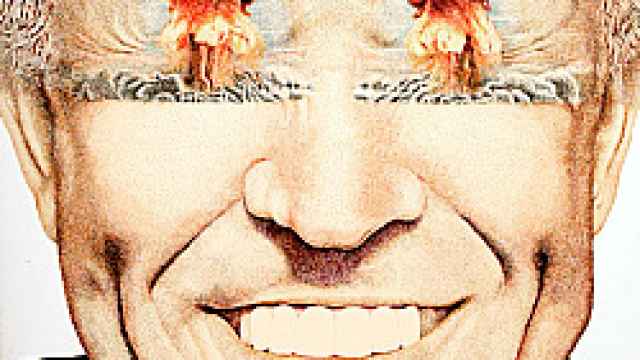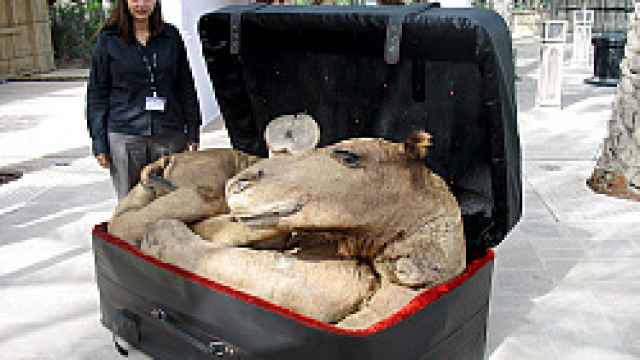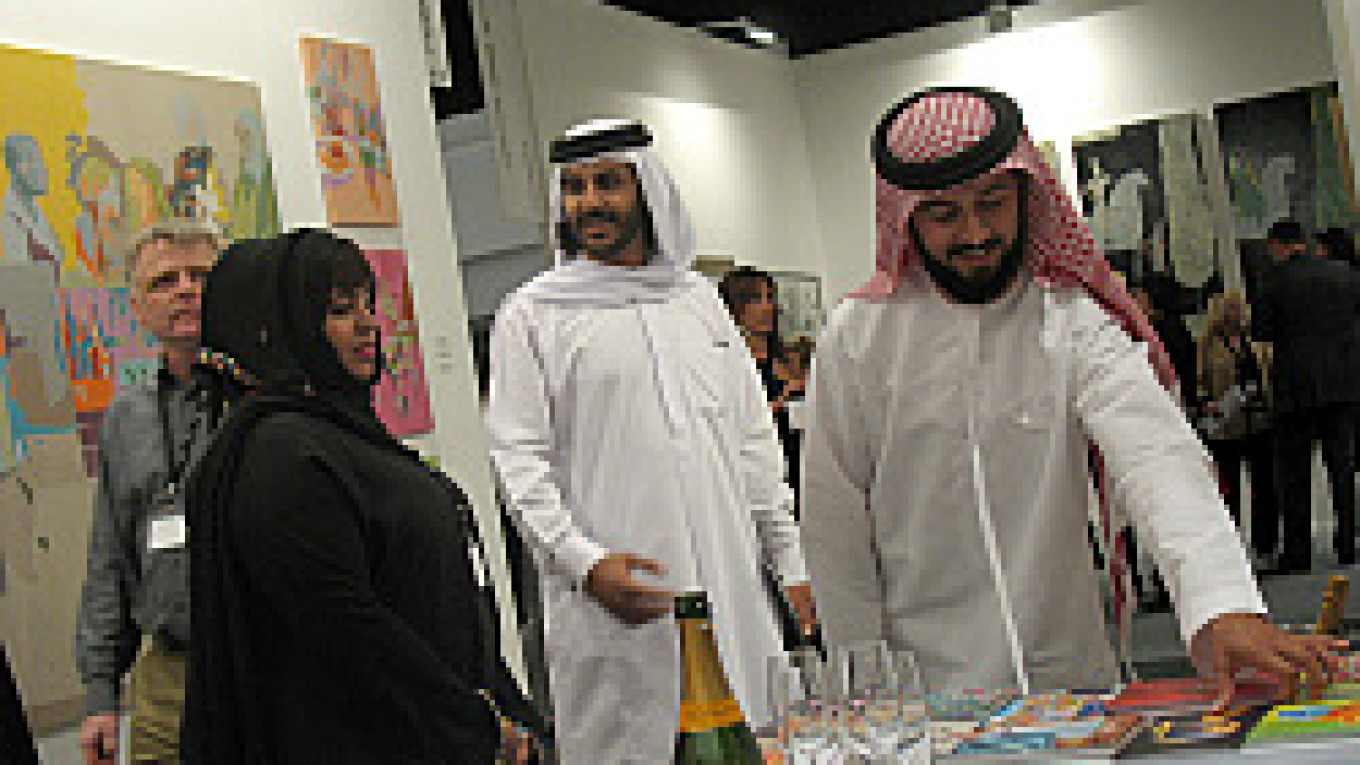This is a man whose opinion matters. His father is the ruler of Dubai, a man whom Forbes magazine called the fourth-richest royal in the world last year, with an estimated fortune of $16 billion. And it is thanks to the support of the young man's family that the emirate became home to Art Dubai, an event that aims to become the leading contemporary art fair in the Middle East.
So when the sheikh stopped to look at "Flying Carpets" by Alex Flemming, the Brazilian artist was eager to explain his work.
"I was trying to design a bridge between East and West," Flemming said, gesturing at the work, a set of wall hangings cut from pieces of carpet into the shape of airplanes.
"It's a very nice design for a bridge," the sheikh replied in fluent English. "It could be a new contract for Airbus."
Whether Art Dubai succeeds depends a lot on whether sheikhs and artists can find a common language. Until recently, the art market had almost no presence in the Persian Gulf. While the region enjoys fantastic wealth, it is also home to traditional, Islamic societies which might seem like unlikely places to find contemporary art collectors.
But amid fears of an economic slowdown in the West, and with soaring oil prices creating huge fortunes in places like Russia and the Middle East, artists and galleries are looking east for new customers.
They have found fertile ground in the United Arab Emirates, a small, sun-drenched nation known as one of the most liberal places in the Persian Gulf region.
The UAE leadership has been on a culture kick lately. Last year, Abu Dhabi unveiled plans for a sprawling cultural district that would include a branch of the Guggenheim Museum and -- despite protests in France -- the first-ever international franchise of the Louvre. Also in 2007, Dubai held the inaugural DIFC Gulf Art Fair, which has since morphed into Art Dubai.
Nearly 70 galleries from around the world set up stands at Art Dubai this week, roughly double the number from last year's event.
 Art Dubai "Allah Eye Doctor," displayed by The Third Line, a Dubai gallery. | |
Generous support from sponsors has helped raise the fair's visibility too. Organizers declined to say how much was spent to produce Art Dubai, but evidence of lavish spending was everywhere on opening night.
Drinks were served at a bar carved from ice in the courtyard, where guests could mingle, snack on dim sum and admire the view of Dubai's most famous skyscraper and seven-star hotel, officially called the Burj Al Arab but commonly known as "the sail." The fair itself took place in the ritzy Madinat Jumeirah Resort, and organizers flew in 40 journalists from around the world to attend the opening.
Russian art fairs would do well to match Art Dubai's level of organization, Moscow artist and gallery owner Aidan Salakhova said in an interview Tuesday.
"There's good service, a pleasant atmosphere; the food is good," said Salakhova, whose Aidan Gallery was the only Russian gallery represented at Art Dubai.
Many gallery owners said they were presenting works in the Middle East for the first time, and many mentioned Russia as another emerging market they wanted to tap.
"We have not developed clients in Russia yet," said Marie-Sophie Eiche, director of the Kamel Mennour gallery in Paris. "But it will come. For sure."
Bonni Benrubi, the owner of an eponymous gallery in New York that specializes in photography, said the shifting global economy had reoriented her gallery toward more international clients.
 Art Dubai "Moderate Fantasy Violence" by London-based Faiza Butt. | |
"Because of the weak dollar, our business is exploding overseas," she said, although she described Russia as a still-untapped market.
"We have only one Russian client, sadly," she said.
Among the most popular works at the Bonni Benrubi Gallery's stand on Tuesday was a series depicting particle accelerators at the CERN Laboratory in Switzerland. British photographer Simon Norfolk captured the vast circular machines from above, producing images of intense, multicolored complexity that Benrubi compared to Tibetan mandalas.
It was an appropriate comparison, perhaps, for a fair where Asian art took center stage, with approximately half the galleries coming from the Middle East, Central Asia and the Far East.
Clusters of visitors gathered at the stands of Gallery Espace from New Delhi, which featured conceptual paintings involving Hindu deities, and the 100 Tonson Gallery from Bangkok, where the centerpiece was an eye-catching sculpture of a reclining pair of legs, titled "Good Old Days (Good for Nothing)," by Thai artist Chatchai Puipia.
At the stand belonging to The Third Line, one of several Dubai galleries, "Allah Eye Doctor" turned the name of the deity into an ophthalmologist's chart, dwindling from huge letters to tiny ones.
A scattering of Western galleries carried big names like Andy Warhol, but the emphasis clearly seemed to be on lesser-known artists with potential appeal in the East.
In sharp contrast to the average contemporary art event in Russia, the fair was totally lacking in sexual explicitness or artworks deliberately calculated to shock. Gallery directors said such works would never fly in the conservative Persian Gulf region, and some added that they would never have gotten past UAE customs.
"I couldn't really bring Blue Noses, unfortunately," said German gallery director Volker Diehl, referring to the notorious Siberian collective that has angered Russian officials with its pictures of kissing policemen and its pastiches of sex romps starring President Vladimir Putin, Osama Bin Laden and U.S. President George W. Bush.
 Alexander Osipovich / MT Pakistani Artist Huma Mulji stands by her exhibit, "Arabian Delights." | |
Diehl, who runs one gallery in Berlin and plans to open another in Moscow next month, had one Russian work on display: a charcoal rendering of Chechen fighters in Adidas tracksuits by Grozny-born artist Alexei Kallima. The gallerist said it was part of a strategy to choose works with the most potential appeal to Dubai buyers.
"East and West was the main idea," Diehl said.
One has to be careful in adapting to Muslim social mores, but there is plenty of room for artistic expression without the use of naked bodies and shock tactics, said Nicolas Iljine, the representative of the Guggenheim Foundation in European and the Middle East.
"You're not trying to make a political confrontation," Iljine said by telephone from his home in France. "You adapt to traditions to a certain extent. And the very fact that they're building a museum of contemporary art right in the middle of the Emirates shows there's a demand for that."
Iljine, who is spearheading the Guggenheim Abu Dhabi and has also been involved in the Moscow Biennale, predicted that the contemporary art scene would take off faster in the UAE than in Russia -- partly because of Russia's notorious bureaucracy, which makes it difficult to organize events.
"In Russia you have a lot of legalistic barriers and an unclear bank system," he said. "That does not make it easy."
In other words, it's a world apart from Dubai, which has carved itself a niche as a low-tax, low-bureaucracy haven for business. The tiny emirate -- which earns most of its revenue from trade and financial services rather than oil and gas extraction -- now wants a contemporary art scene in addition to its list of accomplishments.
One patron of Art Dubai said it was in his "self-enlightened interest" to support the fair.
"We believe that openness and the free flow of ideas are very important," Frederic Sicre, executive director of Abraaj Capital, a UAE-based private equity firm with $5 billion in assets, said at the opening news conference.
For many guests, however, Art Dubai simply offered a chance to gawk at the skyscrapers and luxury hotels, to soak up the sun and to reflect on what it meant for contemporary art to grow out of nothing in the Arabian desert.
"It's really strange," Flemming, the Brazilian artist, said in an interview after his encounter with the sheikh. "It's like science fiction."
A Message from The Moscow Times:
Dear readers,
We are facing unprecedented challenges. Russia's Prosecutor General's Office has designated The Moscow Times as an "undesirable" organization, criminalizing our work and putting our staff at risk of prosecution. This follows our earlier unjust labeling as a "foreign agent."
These actions are direct attempts to silence independent journalism in Russia. The authorities claim our work "discredits the decisions of the Russian leadership." We see things differently: we strive to provide accurate, unbiased reporting on Russia.
We, the journalists of The Moscow Times, refuse to be silenced. But to continue our work, we need your help.
Your support, no matter how small, makes a world of difference. If you can, please support us monthly starting from just $2. It's quick to set up, and every contribution makes a significant impact.
By supporting The Moscow Times, you're defending open, independent journalism in the face of repression. Thank you for standing with us.
Remind me later.


